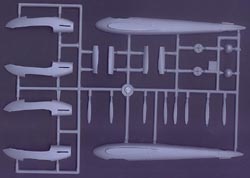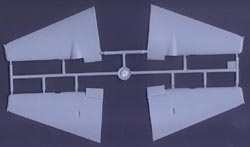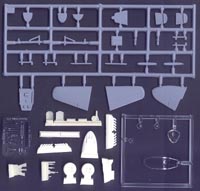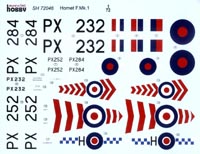Special Hobby 1/72
de Havilland DH103
Hornet F. Mk. 1
|
 |
History
The de Havilland Hornet is easily the most beautiful piston-engined
twin ever built, building on the good looks of the Mosquito and refining
them to exquisite perfection. Like the Mosquito, the Hornet was also mainly
constructed of wood. The first example took to the air on July 28, 1943,
and from early on all the test pilots were impressed by the speed and
maneuverability of the Hornet. Although the first service example reached
the RAF in February of 1945, it did not see action during World War 2.
Although declared obsolete in 1950, the Hornet saw extensive service in
Malaysia and Singapore against terrorists. By 1955, though, the Hornet's
days were numbered, and by 1956 all were retired and scrapped, and sadly
not one example survived.
 The
Kit The
Kit
I have been awaiting a nice kit of the de Havilland Hornet in 1/72 for
quite some time, and finally I have one. The kit comes with a mix of plastic,
resin and photoetch, with the plastic pieces featuring finely recessed
panel lines and an injection-molded canopy. The kit is clearly designed
for other variants, and we will probably see all of the Hornet marks in
the future.
The interior is nicely done, with a combination of plastic and resin
pieces, accented with the standard photoetch instrument panel. The main
cockpit is made from plastic, with a separate floor and rear bulkhead
assembly. The seat, instrument  panel,
control stick, and accessory boxes are all provided in resin, with the
photoetch panel fitting onto the resin piece. Photoetch seat belts are
also included. Once finished and sandwiched between the fuselage halves,
the cramped cockpit will really look the part. Also sandwiched between
the fuselage halves is a resin tailwheel insert. A separate resin chin
piece provides the gun troughs. panel,
control stick, and accessory boxes are all provided in resin, with the
photoetch panel fitting onto the resin piece. Photoetch seat belts are
also included. Once finished and sandwiched between the fuselage halves,
the cramped cockpit will really look the part. Also sandwiched between
the fuselage halves is a resin tailwheel insert. A separate resin chin
piece provides the gun troughs.
Once the fuselage is together, attention can turn towards the wings.
The wings are split into upper and lower halves, into which are sandwiched
resin radiator faces. The finished wing halves are butt-joined to the
fuselage. The engine nacelles are next, split into right and left halves.
There is a separate firewall piece, and a separate prop shaft. Resin exhaust
inserts finish off the nacelles, which mate up to the wings in a  way
to complete the landing gear wells. way
to complete the landing gear wells.
The landing gear comes with a single main strut with a separate bracing
strut and photoetch oleo scissors. Resin wheels and tailwheel round out
the undercarriage. The propellers feature separate blades, a rear plate,
and hub. The blades are handed for each side, so keep them straight during
assembly. While railings and racks are included for underneath the wings,
there is nothing to hang on them.
The decals provide markings for three Hornets. The first example is
a Hornet F.1 of No. 65 Squadron, based at Linton-on-Ouse in 1948. It is
overall silver, with red chevrons on the fuselage and upper wings. The
second option is also from No. 65 Squadron, but from a couple years earlier
than the first option. This time the plane is finished in light gray over
blue and is coded YT-R. The final option is also finished  in
light gray over blue, this time from No. 19 Squadron based at Church Fenton
in 1946-47. This plane is coded 'H' and has blue and white checkers along
the fuselage. The decals are well done and should pose no problems in
application. in
light gray over blue, this time from No. 19 Squadron based at Church Fenton
in 1946-47. This plane is coded 'H' and has blue and white checkers along
the fuselage. The decals are well done and should pose no problems in
application.
Conclusion
I am very pleased with this kit and I cannot wait to see it built up.
This will make for an excellent companion piece to one of the excellent
Mosquito kits out there, or just as a standalone model. Every 1/72 modeler
should get one of these kits and build it, just to have a model of the
most beautiful piston twin ever built.
|
|
